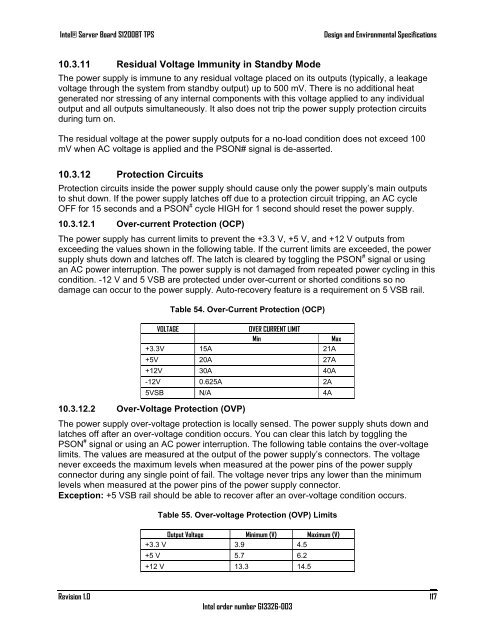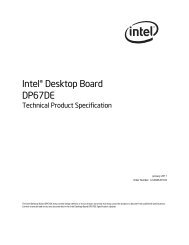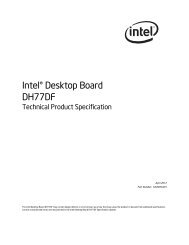Intel Server Board S1200BT - PROconsult Data A/S
Intel Server Board S1200BT - PROconsult Data A/S
Intel Server Board S1200BT - PROconsult Data A/S
Create successful ePaper yourself
Turn your PDF publications into a flip-book with our unique Google optimized e-Paper software.
<strong>Intel</strong>® <strong>Server</strong> <strong>Board</strong> <strong>S1200BT</strong> TPS<br />
Design and Environmental Specifications<br />
10.3.11 Residual Voltage Immunity in Standby Mode<br />
The power supply is immune to any residual voltage placed on its outputs (typically, a leakage<br />
voltage through the system from standby output) up to 500 mV. There is no additional heat<br />
generated nor stressing of any internal components with this voltage applied to any individual<br />
output and all outputs simultaneously. It also does not trip the power supply protection circuits<br />
during turn on.<br />
The residual voltage at the power supply outputs for a no-load condition does not exceed 100<br />
mV when AC voltage is applied and the PSON# signal is de-asserted.<br />
10.3.12 Protection Circuits<br />
Protection circuits inside the power supply should cause only the power supply‘s main outputs<br />
to shut down. If the power supply latches off due to a protection circuit tripping, an AC cycle<br />
OFF for 15 seconds and a PSON # cycle HIGH for 1 second should reset the power supply.<br />
10.3.12.1 Over-current Protection (OCP)<br />
The power supply has current limits to prevent the +3.3 V, +5 V, and +12 V outputs from<br />
exceeding the values shown in the following table. If the current limits are exceeded, the power<br />
supply shuts down and latches off. The latch is cleared by toggling the PSON # signal or using<br />
an AC power interruption. The power supply is not damaged from repeated power cycling in this<br />
condition. -12 V and 5 VSB are protected under over-current or shorted conditions so no<br />
damage can occur to the power supply. Auto-recovery feature is a requirement on 5 VSB rail.<br />
Table 54. Over-Current Protection (OCP)<br />
VOLTAGE<br />
OVER CURRENT LIMIT<br />
Min<br />
Max<br />
+3.3V 15A 21A<br />
+5V 20A 27A<br />
+12V 30A 40A<br />
-12V 0.625A 2A<br />
5VSB N/A 4A<br />
10.3.12.2 Over-Voltage Protection (OVP)<br />
The power supply over-voltage protection is locally sensed. The power supply shuts down and<br />
latches off after an over-voltage condition occurs. You can clear this latch by toggling the<br />
PSON # signal or using an AC power interruption. The following table contains the over-voltage<br />
limits. The values are measured at the output of the power supply‘s connectors. The voltage<br />
never exceeds the maximum levels when measured at the power pins of the power supply<br />
connector during any single point of fail. The voltage never trips any lower than the minimum<br />
levels when measured at the power pins of the power supply connector.<br />
Exception: +5 VSB rail should be able to recover after an over-voltage condition occurs.<br />
Table 55. Over-voltage Protection (OVP) Limits<br />
Output Voltage Minimum (V) Maximum (V)<br />
+3.3 V 3.9 4.5<br />
+5 V 5.7 6.2<br />
+12 V 13.3 14.5<br />
Revision 1.0<br />
<strong>Intel</strong> order number G13326-003<br />
117















